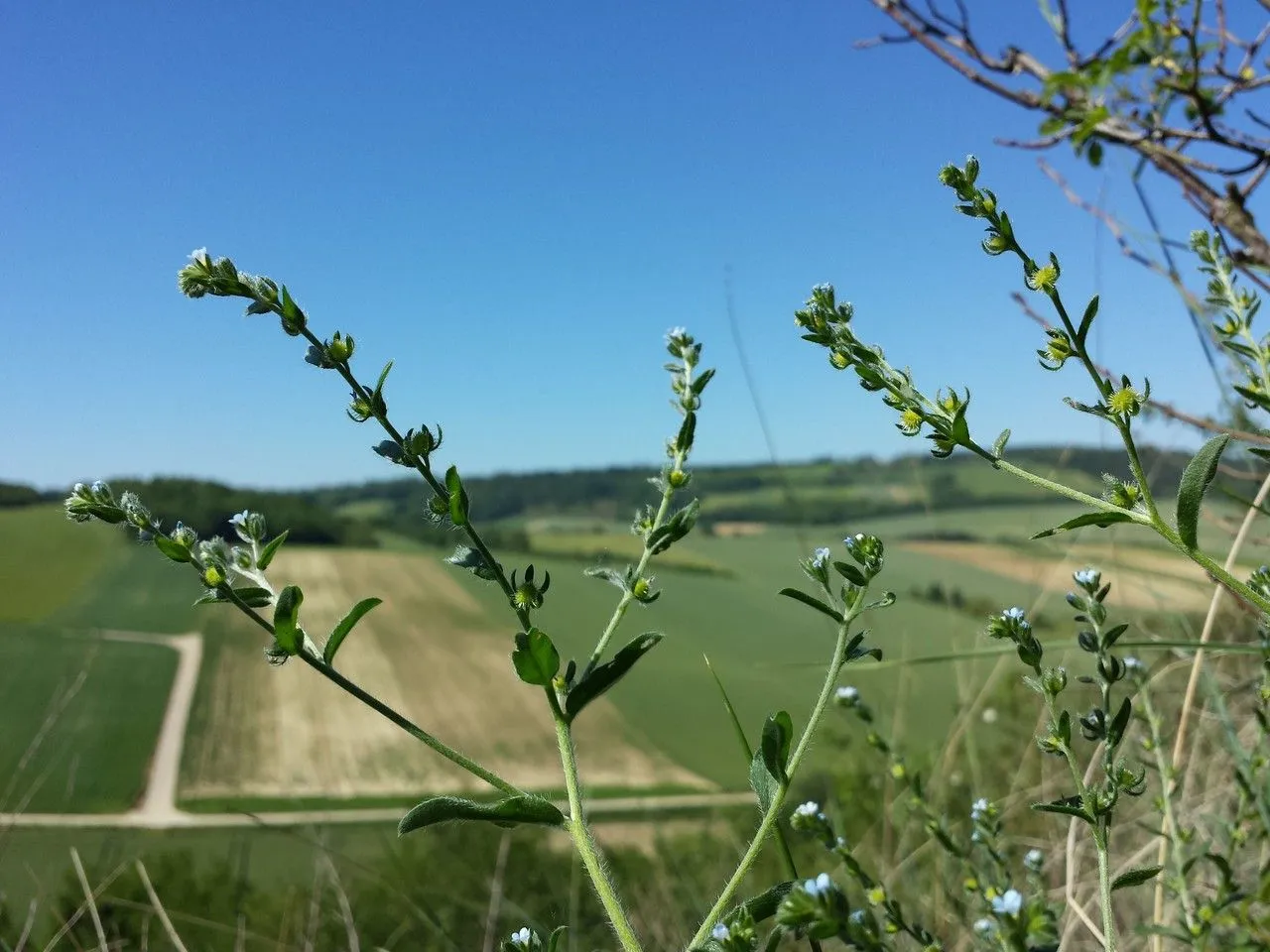
Author: (Retz.) Dumort.
Bibliography: Fl. Belg.: 40 (1827)
Year: 1827
Status: accepted
Rank: species
Genus: Lappula
Vegetable: False
Observations: Temp. Eurasia
Bur-forget-me-not, scientifically known as Lappula squarrosa, is a captivating plant species renowned not only for its delicate beauty but also for its widespread presence across temperate regions of Eurasia. This plant emanates from the Boraginaceae family, a group characterized by its often hairy, tough leaves and blue-hued flowers.
Lappula squarrosa was first documented extensively in 1827 under the meticulous authorship of (Retz.) Dumort., as referenced in Fl. Belg.: 40. The comprehensive study highlights its botanical characteristics and the conditions favorable for its growth and proliferation.
In appearance, the Bur-forget-me-not is distinguished by its charming small blue flowers which resemble those of the traditional forget-me-not. However, this species is uniquely marked by burrs on its fruit, which contribute to its common name. These burrs adhere to animal fur and clothing, facilitating seed dispersal and thus, supporting the plant’s extensive spread across various regions.
Habitat-wise, Bur-forget-me-not thrives in a range of temperate climates across Eurasia. It is often found in meadows, along roadsides, and within light woodlands, showcasing its adaptability to different soil types and environmental conditions.
Ecologically, Lappula squarrosa plays a significant role in its native habitats. It provides nectar for a variety of pollinators, including bees, which are crucial for maintaining ecological balance and biodiversity. Furthermore, its presence in diverse environments highlights its resilience and the evolutionary success of the Boraginaceae family.
In summary, Bur-forget-me-not is more than just a pretty face in the world of botany. Its historical documentation, widespread habitat, and ecological significance collectively spotlight Lappula squarrosa as a plant of considerable interest and importance within the diverse tapestry of Eurasian flora.
Eng: bluebur, bur forget-me-not, bur-forget-me-not, european stickseed, bristly stickseed, two-rowed stickseed, bristly sheepburr, bristly-fruit stickweed, two-row stickweed
Deu: kletten-igelsame
Dan: småhaget pigfrø
Fra: bardanette, bardanette hérissée, bardanette épineuse, bardanette squarreuse, bardenette hérissée
Lav: ežadatu lipene
Swe: piggfrö
Ces: strošek pomněnkový
Nld: stekelzaad
Sme: šilljobiikasiepman
Cym: sgorpionllys gwrychog
En: Bur-forget-me-not, Bluebur, European stickseed, BRISTLY SHEEPBURR, Bristly sticktight, Bur Forget-me-not, Bristly stickseed, Two-rowed stickseed, Bristly-fruit stickweed, Two-row stickweed
Be: Ліпучка вожыкападобная
Cs: Strošek pomněnkový
Da: Småhaget pigfrø
Nl: Stekelzaad
Et: Siil-takelrohi
Fi: Kyläsirkunjyvä
Fr: Bardanette, Bardanette hérissée, Bardanette épineuse, Bardanette squarreuse, Bardenette hérissée, Bardanette faux myosotis, Faux Myosotis, Bardanette raboteuse, Fausse Bardane raboteuse
Ka: Ჩვეულებრივი ჩიტის ბირკა
De: Kletten-Igelsame, Acker-Igelsame, Gewöhnlicher Igelsame, Stechender Igelsame
It: Lappolina comune
Lv: Ežadatu lipene
Se: Šilljobiikasiepman
Pl: Lepnik zwyczajny
Ru: Липучка оттопыренная
Sv: Piggfrö
Cy: Sgorpionllys gwrychog
Taken Aug 8, 2021 by Chelsea Jeeves (cc-by-sa)
Taken Nov 15, 2021 by Taylor Shook (cc-by-sa)
Taken Jun 12, 2022 by Birdy Loughlin (cc-by-sa)
Taken Jun 12, 2022 by Birdy Loughlin (cc-by-sa)
Taken Oct 8, 2022 by Stephanie Desroches (cc-by-sa)
Taken Jun 29, 2020 by Anna (cc-by-sa)
Taken Jun 10, 2019 by jacobs enrico (cc-by-sa)
Taken Jun 26, 2022 by Алена Подольская (cc-by-sa)
Taken Nov 15, 2021 by Taylor Shook (cc-by-sa)
Taken Oct 8, 2022 by Stephanie Desroches (cc-by-sa)
Taken Aug 15, 2004 by Photoflora – Jean-Luc TASSET (©)
Taken Jul 15, 2005 by Photoflora – Jean-Luc TASSET (©)
Taken Jan 1, 1900 by EOL − Lappula_squarrosa3.JPG: Rolf Engstrand. derivative work: F. Lamiot (cc-by)
Taken Jan 1, 1900 by EOL − Matt Lavin from Bozeman, Montana, USA (cc-by)
Taken Nov 15, 2021 by Taylor Shook (cc-by-sa)
Taken Jan 1, 1900 by EOL − Stefan.lefnaer (cc-by-sa)
Taken Jan 1, 1900 by EOL − Stefan.lefnaer (cc-by-sa)
Taken Jan 1, 1900 by EOL − Stefan.lefnaer (cc-by-sa)
Taken Jan 1, 1900 by EOL − Stefan.lefnaer (cc-by-sa)
Taken Jan 1, 1900 by EOL − Stefan.lefnaer (cc-by-sa)
© copyright of the Board of Trustees of the Royal Botanic Gardens, Kew.
© copyright of the Board of Trustees of the Royal Botanic Gardens, Kew.
© copyright of the Board of Trustees of the Royal Botanic Gardens, Kew.
Taken Jul 15, 2005 by Photoflora – Benoit BOCK (©)
Taken Jul 15, 2002 by Photoflora – Benoit BOCK (©)
Taken Jan 1, 1970 by Photoflora – L’Abbé COSTE (©)
Taken Jul 15, 2008 by Photoflora – Benoit BOCK (©)
Taken Jul 15, 2003 by Photoflora – Jean-Luc TASSET (©)
Growth habit: Forb/herb
Ph maximum: 7.5
Ph minimum: 7.0
Light: 8
Atmospheric humidity: 4
Soil nutriments: 7
Family: Myrtaceae Author: (F.Muell.) K.D.Hill & L.A.S.Johnson Bibliography: Telopea 6: 402 (1995) Year: 1995 Status:…
Family: Rubiaceae Author: Pierre ex A.Froehner Bibliography: Notizbl. Bot. Gart. Berlin-Dahlem 1: 237 (1897) Year:…
Family: Sapindaceae Author: Koidz. Bibliography: J. Coll. Sci. Imp. Univ. Tokyo 32(1): 38 (1911) Year:…
Family: Asteraceae Author: A.Gray Bibliography: Pacif. Railr. Rep.: 107 (1857) Year: 1857 Status: accepted Rank:…
Family: Fabaceae Author: Medik. Bibliography: Vorles. Churpfälz. Phys.-Ökon. Ges. 2: 398 (1787) Year: 1787 Status:…
Family: Aspleniaceae Author: (Cav.) Alston Bibliography: Bull. Misc. Inform. Kew 1932: 309 (1932) Year: 1932…